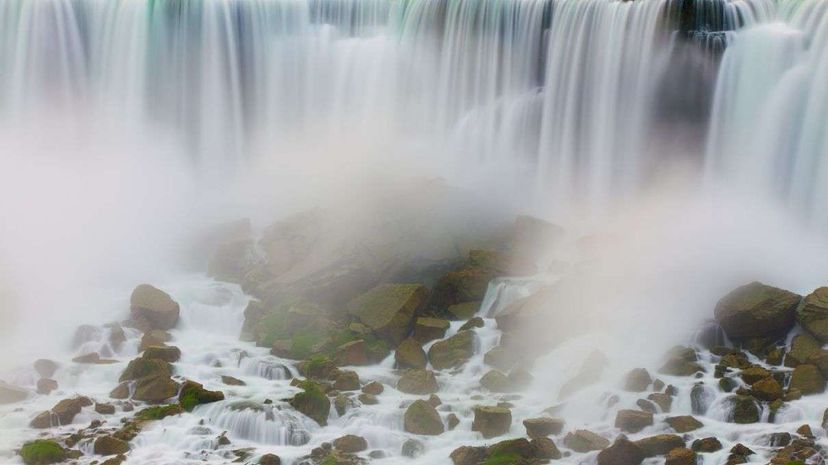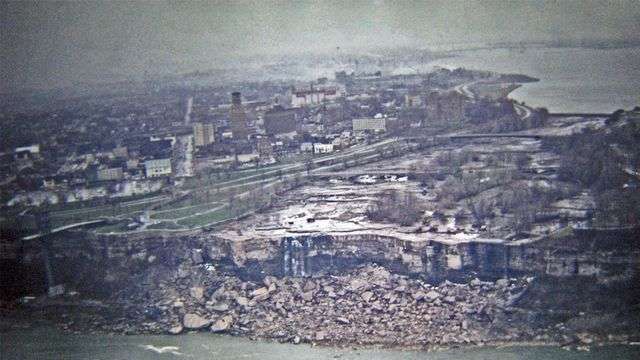
This Wednesday, New York State held a public hearing at the Niagara Falls Conference Center to discuss a proposal to "dewater" Niagara Falls. The plan is to cut off the water on the U.S. side of the falls for five to nine months to repair two deteriorating 115-year-old bridges.
The two stone and concrete bridges, built more than a century ago in 1900-01, have been causing the park trouble for a while. In 2004, the base of one of the stone bridges collapsed, and two temporary truss bridges were fitted overtop the existing structures. Now, over ten years later, those temporary bridges are beginning to deteriorate, too.
Advertisement
The bridges' narrow, uneven structure and steep approach mean that they're treacherous for pedestrians and bicyclists, and they aren't Americans with Disabilities Act (ADA) compliant either. Plus, as the proposal for the project points out, they are "visually unappealing and impede viewing access of the American Rapids, significantly detracting from the park visitor experience."
The American Rapids, for those unfamiliar, are part of "Niagara Falls," a combined term for three waterfalls stemming from the Niagara River. That trio includes Horseshoe Falls, in Canada, and the American and Bridal Veil Falls, in the U.S.
Normally, around 85 percent of the Niagara River flows over Horseshoe Falls, and the remaining 15 percent falls over the U.S. side of the falls. Once a cofferdam is installed for the project, the water from the U.S. side will be redirected to Horseshoe Falls. At present, it's not clear how the upcoming project will affect the Canadians, and none of the sources HSW interviewed could address the issue.
The plans for the project are still in the early stages. The necessary funds, estimated to be between $21 and $37 million, will not be secured until after the plan is approved. That should happen next summer, after a public comment period.
If approved, this won't be the first time the falls have been dewatered. Back in 1965, an article in the Niagara Falls Gazette about erosion and the impending "death" of Niagara Falls sparked public outcry. In response, the U.S. side of Niagara Falls was shut off for roughly five months as part of a $90,000 erosion study by the United States Army Corps of Engineers.

That project had its fair share of unexpected consequences. Within days of turning off the water, police had found the remains of a man, a woman and — a deer. And although New York State Parks was thrilled to see record-breaking tourist attention, police struggled to keep tourists off unauthorized areas of the dry riverbed.
There were also environmental side effects.
"Back in 1969, there was at least one unexpected catastrophe. Thousands of channel trees died as a result of the dewatering. Trees situated on islands in the Niagara River that were normally nourished by the rushing waters and were lodged in rock basically died of thirst," writes Michelle Kratts, the most recent (and now retired) Niagara Falls historian, via email.
The study also caused some damage to the rock face itself. The American Falls are layered. Just under the top layer of dolomite is a layer of softer rock called shale, which is primarily composed of clay and a few other minerals. Without the continuous flow of water, the shale started to crumble, prompting accelerated construction of sprinklers to keep the shale moist, although it didn't completely prevent continued deterioration and rockslides.
Angela P. Berti, the public information officer for the New York State Office of Parks, Recreation and Historic Preservation in Niagara Falls, says environmental concerns for this project will be addressed in the future.
"Please keep in mind that at this point, today, we are simply bringing three options for bridge replacement. Then we need to locate funding for what is chosen and THEN we will be doing those kinds of details," says Berti.
The proposal does mention a few environmental concerns such as the potential temporary displacement of some local bird species, including some sensitive species such as peregrine falcons and double-crested cormorants. However, the project is working with the New York State Department of Environmental conservation to assess and minimize impact to local wildlife.
On top of allowing for the much-needed construction of new bridges, the dewatered falls are expected to be a potential boon to the local economy. After all, this could be a "once-in-a-lifetime opportunity to see the falls and river channel without water," as the proposal states."
Kratts agrees, noting the large spikes in attendance in 1969.
"There were great numbers of people. Some were disappointed that they had come so far and the falls were 'shut off.' Others were quite intrigued and thrilled to be a part of this historic moment," she says.
She adds, '"I have seen all of the tweets and posts throughout social media and mostly everyone is saying how much they want to be here if this happens."
Although the falls likely won't be shut off for more than two years, you can follow the progress on the project's website.
According to Kratts, the dewatering of the falls will likely be one of the most historic events of our lifetime.
"We are so accustomed to the falling waters, they define us here in NF. When they are quiet, there will be so much to discover and so many mysteries that will be revealed," she says.
Advertisement